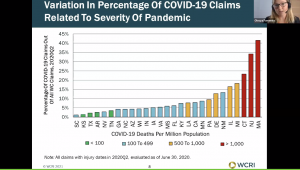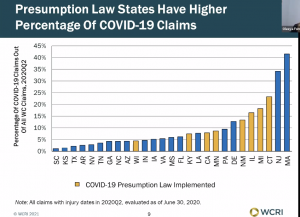The 2021 WCRI Annual Issues and Research confab kicked off today with several excellent presentations – not surprisingly there was a lot about COVID and its impact on employment, injuries, and claims.
The conference continues tomorrow – register here if you haven’t already…
I’ll get to those in later posts, but will start our coverage with Dr. Olesya Fomenko; she gave a very well-done – and very well-attended presentation on claims during COVID. Note that some of the findings and graphics may be preliminary so subject to change
Regarding COVID claims for Q2 2020 there was wide variation in the volume of COVID claims between the study states; in Massachusetts 42% of claims were COVID, compared to 1% in SC. On average 6% of claims in median state were due to COVID. COVID claims were-disproportionally LT claims.
There are a variety of reasons for these differences. Massachusetts has pay without prejudice, NJ’s presumption law went into effect pretty early, and the timing and severity of pandemic, impact of shutdowns and social distancing all affected the variability across states.
There was a relatively strong association between the COVID death rate and number of WC claims for COVID; this seemed to be more of an influence than presumption (slide below).


Not surprisingly the number of non-COVID claims dropped dramatically in Q2 2020 in WCRI’s study states; the majority of states had at least a 30% drop in non-COVID claims, with MA’s claims cut in half. Employment also dropped dramatically, but there wasn’t much of a correlation between states’ employment reduction and drop in WC claims
Injury types weren’t didn’t change much from pre to post – altho the percentage of claims that were LT increased. [This finding echoed research discussed by CWCI a few days ago]
Again, similar to CWCI’s research, there was no evidence of treatment delays for claims with injury dates in the first half of 2020. In fact, there was a slight improvement in time to surgery and PT. That holds true except for ER services which declined, perhaps driven by reluctance to go to a place where COVID might be present.
What does this mean for you?
Assumptions are dangerous – we now know that medical care wasn’t delayed, that COVID claims weren’t expensive (see CWCI), and that (shocker!) COVID claims counts were lower in states that did more to stop its spread.
Kudos to WCRI for excellent research giving us a much deeper understanding of the impact of the pandemic – and what drove the interstate differences. And thanks to the organizations that support WCRI – you are helping all of us.


